-
![Charles Virmaitre. Paris-police. — Paris: E. Dentu, 1886. — pp.: [2 wrapper], [2 half-title], 2 title] 1-359 [1 blank], back wrapper.](https://varshavskycollection.com/wp-content/uploads/2021/02/LIB-1130.2016-d-scaled-500x500.jpeg) Cover: (black and red in red frame) PARIS POLICE | par | Ch. Virmaitre | PARIS | E. DENTU, ÉDITEUR | LIBRAIRE DE LA SOCIÉTÉ DES GENTES DE LETTRES | Palais-Royal, 15-17-19, Galerie d’Orléans | 1886 || Title page: CH. VIRMAITRE | PARIS–POLICE | {publisher’s device} | PARIS | E. DENTU, ÉDITEUR | LIBRAIRE DE LA SOCIÉTÉ DES GENTES DE LETTRES | PALAIS-ROYAL, 15-17-19, GALERIE D’ORLEANS | 1886 | Tous droits réservés. || Pagination : 3 blank leaves, original pictorial wrapper, [4], [1] 2-359 [360 blank], original back wrapper with publisher's advertisement, 3 blank leaves. Collation: 12mo; π2, 1-1912 206. Binding: owner's hardcover, quarter burgundy percaline, marbled boards, brown title label with gilt lettering, gilt double tail ruler, year, and fleuron to spine; original paper wrappers preserved.
Cover: (black and red in red frame) PARIS POLICE | par | Ch. Virmaitre | PARIS | E. DENTU, ÉDITEUR | LIBRAIRE DE LA SOCIÉTÉ DES GENTES DE LETTRES | Palais-Royal, 15-17-19, Galerie d’Orléans | 1886 || Title page: CH. VIRMAITRE | PARIS–POLICE | {publisher’s device} | PARIS | E. DENTU, ÉDITEUR | LIBRAIRE DE LA SOCIÉTÉ DES GENTES DE LETTRES | PALAIS-ROYAL, 15-17-19, GALERIE D’ORLEANS | 1886 | Tous droits réservés. || Pagination : 3 blank leaves, original pictorial wrapper, [4], [1] 2-359 [360 blank], original back wrapper with publisher's advertisement, 3 blank leaves. Collation: 12mo; π2, 1-1912 206. Binding: owner's hardcover, quarter burgundy percaline, marbled boards, brown title label with gilt lettering, gilt double tail ruler, year, and fleuron to spine; original paper wrappers preserved. -
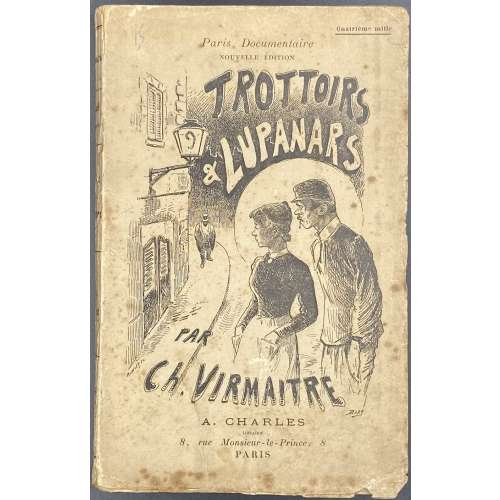 Front wrapper: Quatrième mille | Paris Documentaire | NOUVELLE ÉDITION | TROTTOIRS | ET | LUPANARS | PAR | Ch. VIRMAITRE | A. CHARLES | LIBRAIRE | 8, Rue Monsieur-le-Prince, 8 | PARIS || Title page: Ch. VIRMAITRE | PARIS DOCUMENTAIRE | (Mœurs) | TROTTOIRS | ET | LUPANARS | {fleuron} | A. CHARLES | LIBRAIRE | 8, Rue Monsieur-le-Prince, 8 | PARIS | 1897 || Collation: 18mo; Front pictorial wrapper, 2 ffls, π4, 118, 318, 518, 718, 918, 1118, 1318, 1514, back pictorial wrapper (portrait) Pagination: [1-7] 8-282 [6]. Binding: Publisher’s pictorial wrappers, lettering to spine. Charles Virmaître (French, 1835 – 1903).
Front wrapper: Quatrième mille | Paris Documentaire | NOUVELLE ÉDITION | TROTTOIRS | ET | LUPANARS | PAR | Ch. VIRMAITRE | A. CHARLES | LIBRAIRE | 8, Rue Monsieur-le-Prince, 8 | PARIS || Title page: Ch. VIRMAITRE | PARIS DOCUMENTAIRE | (Mœurs) | TROTTOIRS | ET | LUPANARS | {fleuron} | A. CHARLES | LIBRAIRE | 8, Rue Monsieur-le-Prince, 8 | PARIS | 1897 || Collation: 18mo; Front pictorial wrapper, 2 ffls, π4, 118, 318, 518, 718, 918, 1118, 1318, 1514, back pictorial wrapper (portrait) Pagination: [1-7] 8-282 [6]. Binding: Publisher’s pictorial wrappers, lettering to spine. Charles Virmaître (French, 1835 – 1903). -
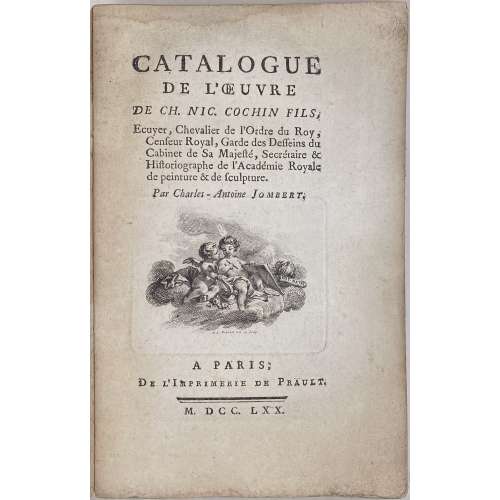 Description: one volume 20 x 12.8 cm, collated 8vo, in grey wrappers (original?), printed on laid paper, with tall “s”, two vignettes by Benoît-Louis Prévost to A1 and A3, 320 entries, where entry 320 Portraits et médaillons, consists of 121 entries itself. Title-page: CATALOGUE | DE L'ŒUVRE | DE CH. NIC. COCHIN FILS, | Ecuyer, Chevalier de l’Ordre du Roy, | Censeur Royal, Garde des Desseins du | Cabinet de Sa Majesté, Secrétaire & | Historiographe de l'Académie Royale | de peinture & de sculpture. | Par Charles-Antoine Jombert. | {vignette by Benoît-Louis Prévost} | A PARIS ; | De l’Imprimerie de Prault. | — | M. DCC. LXX. || Collation: A-I8, K1 (approbation), χ 8 (blanks), two in-text vignettes, total 81 leaves. Pagination: [1-5] 6-144 [145] [17 blanks], ils.; total 162 pages. Ref: Gallica-BnF. Contributors: Charles-Antoine Jombert (French, 1712 – 1784) – author. Charles Nicolas Cochin (French, 1715 – 1790) Benoît-Louis Prévost (French, 1735/47 – 1804) Laurent-François Prault (French, 1712 – 1780)
Description: one volume 20 x 12.8 cm, collated 8vo, in grey wrappers (original?), printed on laid paper, with tall “s”, two vignettes by Benoît-Louis Prévost to A1 and A3, 320 entries, where entry 320 Portraits et médaillons, consists of 121 entries itself. Title-page: CATALOGUE | DE L'ŒUVRE | DE CH. NIC. COCHIN FILS, | Ecuyer, Chevalier de l’Ordre du Roy, | Censeur Royal, Garde des Desseins du | Cabinet de Sa Majesté, Secrétaire & | Historiographe de l'Académie Royale | de peinture & de sculpture. | Par Charles-Antoine Jombert. | {vignette by Benoît-Louis Prévost} | A PARIS ; | De l’Imprimerie de Prault. | — | M. DCC. LXX. || Collation: A-I8, K1 (approbation), χ 8 (blanks), two in-text vignettes, total 81 leaves. Pagination: [1-5] 6-144 [145] [17 blanks], ils.; total 162 pages. Ref: Gallica-BnF. Contributors: Charles-Antoine Jombert (French, 1712 – 1784) – author. Charles Nicolas Cochin (French, 1715 – 1790) Benoît-Louis Prévost (French, 1735/47 – 1804) Laurent-François Prault (French, 1712 – 1780) -
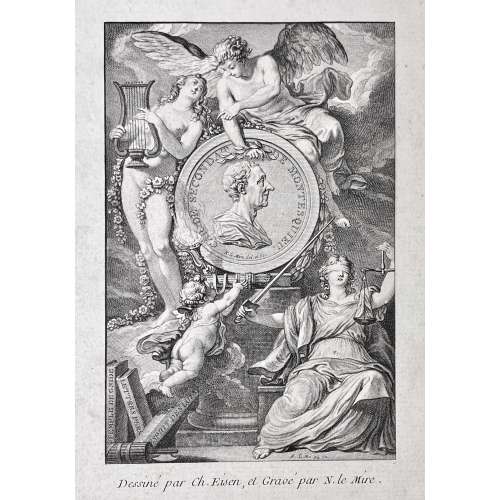 Hardcover volume, 8vo, 24.3 x 16.5 cm, bound in contemporary full marbled calf, spine with raised bands, gilt floral tools in compartments, gilt title lettering, marbled end-papers and all edges, printed on laid paper 23.9 x 5.5 cm with a watermark, entirely engraved (frontispiece, title, nine plates, and text), gatherings not indicated. Title-page (engraved, vignette, tall 's') LE | TEMPLE | DE | GNIDE | Nouvelle Edition, | Avec Figures | Gravées par N. LE MIRE, | des Acad. De Vienne en Autriche et de Rouen, | D’apres les Dessins de Ch. Eisen. | Le Texte Gravé par Droüet. | — | {3 lines quotation from Gallien} | A PARIS | Chez le Mire Graveur | Rue St. Etienne des Gres. | AVEC PRIVELEGE DU ROI. | 1772. || Frontispiece (engraved, vignette): Portrait medallion inscribed "CHARLES SECONDAT DE MONTESQUIEU — N. Le Mire del et sc", signed beneath "N. le Mire sculp 1771"; under the plate: "Dessiné par Ch. Eisen, et Gravé par N. le Mire." Pagination: frontispiece, t.p. / explication, dedication, [i] ii-vii [viii blank] 1-104 [105-6 blanks]; engraved throughout, plus 9 plates by Le Mire after Eisen.Catalogue Raisonné: Cohen-de Ricci 726-27; Ray, French Illustrated Book, №32/p. 61-2.Ref.: MFA (Boston): Accession Number 37.1726.Charles Eisen (French, 1720 – 1778) – artist. Noël Le Mire (French, 1724 – 1801) – engraver, publisher. Droüet (French, 18th century) – text engraver. Charles Louis de Secondat, Baron de La Brède et de Montesquieu (French, 1689 – 1755) – author.
Hardcover volume, 8vo, 24.3 x 16.5 cm, bound in contemporary full marbled calf, spine with raised bands, gilt floral tools in compartments, gilt title lettering, marbled end-papers and all edges, printed on laid paper 23.9 x 5.5 cm with a watermark, entirely engraved (frontispiece, title, nine plates, and text), gatherings not indicated. Title-page (engraved, vignette, tall 's') LE | TEMPLE | DE | GNIDE | Nouvelle Edition, | Avec Figures | Gravées par N. LE MIRE, | des Acad. De Vienne en Autriche et de Rouen, | D’apres les Dessins de Ch. Eisen. | Le Texte Gravé par Droüet. | — | {3 lines quotation from Gallien} | A PARIS | Chez le Mire Graveur | Rue St. Etienne des Gres. | AVEC PRIVELEGE DU ROI. | 1772. || Frontispiece (engraved, vignette): Portrait medallion inscribed "CHARLES SECONDAT DE MONTESQUIEU — N. Le Mire del et sc", signed beneath "N. le Mire sculp 1771"; under the plate: "Dessiné par Ch. Eisen, et Gravé par N. le Mire." Pagination: frontispiece, t.p. / explication, dedication, [i] ii-vii [viii blank] 1-104 [105-6 blanks]; engraved throughout, plus 9 plates by Le Mire after Eisen.Catalogue Raisonné: Cohen-de Ricci 726-27; Ray, French Illustrated Book, №32/p. 61-2.Ref.: MFA (Boston): Accession Number 37.1726.Charles Eisen (French, 1720 – 1778) – artist. Noël Le Mire (French, 1724 – 1801) – engraver, publisher. Droüet (French, 18th century) – text engraver. Charles Louis de Secondat, Baron de La Brède et de Montesquieu (French, 1689 – 1755) – author. -
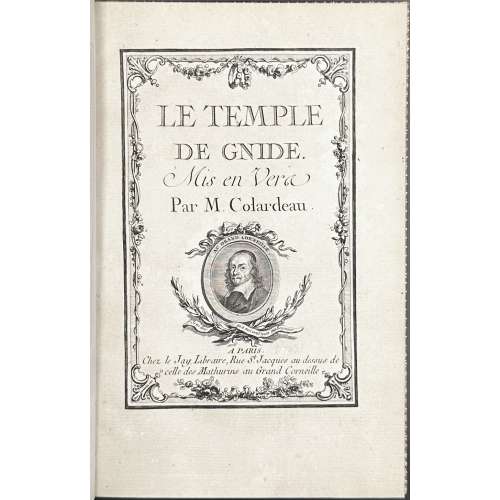 Hardcover volume, 8vo, 21.5 x 14.5 cm, bound by Riviere & Son (stamped on fep verso bottom) in full brown calf, boards with triple gilt fillet border and gilt dentelle inside, spine with raised bands, gilt in compartments, black label with gilt lettering, all margins gilt, blue endpapers, bookplate of Arthur Rau pasted to front pastedown (text: Les hommes sont méchants mais leurs livres sont bons / Arthur Rau; signed: E. H. New – A.D. 1922), traces of removed owner’s label to fep recto; printed on laid paper. Title-page (engraved, in floral frame): LE TEMPLE | DE GNIDE. | Mis en Vers | Par M. Colardeau | {vignette with portrait of Pierre Corneille} | A PARIS | Chez le Jay, Libraire, Rue St. Jacques au dessus de | celle des Mathurins au Grand Corneille || Collation: 2 blanks, h.t., engraved t.p. with a portrait of Pierre Corneille, a8, A-E8 F4 (52 leaves), 2 blanks, plus 7 plates by various engravers after Charles Monnet. Pagination: [i] ii-xvi, [1] 2-88 (104 pp). Ref: MFA (Boston): accession number 37.1747 Catalogue raisonné: Lewine 114, Cohen-DeRicci 245-6. Contributors: Charles Monnet (French, 1732 – after 1808) – artist. Engravers: Jean Charles Baquoy (French, 1721 – 1777) Nicolas Delaunay (French, 1739 – 1792) Isidore Stanislas Helman (French, 1743 – 1806) Louis Joseph Masquelier (French, 1741 – 1811) François Denis Née (French, 1735 – 1818) Nicholas Ponce (French, 1746 – 1831) Portrait(s) designed by: Guillaume Voiriot (French, 1713 – 1799) Author: Charles-Pierre Colardeau (French, 1732 – 1776) Publisher: Edmé-Jean Le Jay (French, 1734 – 1795) Bookplate artist: Edmund Hort New (British, 1871 – 1931) Provenance: Arthur Rau (British, 1898 – 1972); his obituary can be found in The Book Collector 1973, vol. 22, n°1, p. 86-89. According to the genealogy service Geni, Arthur Aron Rau was born to Jacob Aryeh Rau and Katharina (Kaethe) Rau, and has a sister Cecilia (Tsipporah) Rosenfelder and a brother Frederick Solomon Rau. He went to Oxford and then joined Maggs Brothers in their Paris establishment. "After some years there, he set up on his own, returning to England at the outbreak of the Second World War to be a schoolmaster for ten years". In 1949 he returned to Paris and retired in 1963, "and his last years he happily spent in Wensleydale...". All he published during his lifetime were two catalogues, Livres Rares Et Anciens. Manuscrits et Autographes. — Paris: Arthur Rau, 1932-3 and Cinquante Tres Beaux Livres Avec Un Appendice. — Paris: Arthur Rau, 1933. He also contributed to The Book Collector.Seller’s description: In-8° : [2]-t. gr.-xvi-88 pp. ; 7 h.-t. (qqs rouss.). - Poème d'après le roman de Montesquieu ill. de 7 eaux-fortes par Bacquoy, Delaunay, Née, etc., d'après Charles Monnet. Titre gr. orné d'un portr. de Corneille. Cohen, qui cite un ex. millésimé 1773, signale des ex. avec la date de 1772 ou sans date. - Réf. Cohen 245-246. - Conlon 72:675 (éd. à l'adresse d'Amsterdam et Paris, 1772). - Pas dans Reynaud. - Prov. Arthur Rau (1898-1972), gérant de la librairie Maggs à Paris avant d'ouvrir sa propre librairie en 1932 (ex-libris gr. par E.H. New, 1922 ; réf. BnF). - Traces d'ex-libris décollé à la garde sup.
Hardcover volume, 8vo, 21.5 x 14.5 cm, bound by Riviere & Son (stamped on fep verso bottom) in full brown calf, boards with triple gilt fillet border and gilt dentelle inside, spine with raised bands, gilt in compartments, black label with gilt lettering, all margins gilt, blue endpapers, bookplate of Arthur Rau pasted to front pastedown (text: Les hommes sont méchants mais leurs livres sont bons / Arthur Rau; signed: E. H. New – A.D. 1922), traces of removed owner’s label to fep recto; printed on laid paper. Title-page (engraved, in floral frame): LE TEMPLE | DE GNIDE. | Mis en Vers | Par M. Colardeau | {vignette with portrait of Pierre Corneille} | A PARIS | Chez le Jay, Libraire, Rue St. Jacques au dessus de | celle des Mathurins au Grand Corneille || Collation: 2 blanks, h.t., engraved t.p. with a portrait of Pierre Corneille, a8, A-E8 F4 (52 leaves), 2 blanks, plus 7 plates by various engravers after Charles Monnet. Pagination: [i] ii-xvi, [1] 2-88 (104 pp). Ref: MFA (Boston): accession number 37.1747 Catalogue raisonné: Lewine 114, Cohen-DeRicci 245-6. Contributors: Charles Monnet (French, 1732 – after 1808) – artist. Engravers: Jean Charles Baquoy (French, 1721 – 1777) Nicolas Delaunay (French, 1739 – 1792) Isidore Stanislas Helman (French, 1743 – 1806) Louis Joseph Masquelier (French, 1741 – 1811) François Denis Née (French, 1735 – 1818) Nicholas Ponce (French, 1746 – 1831) Portrait(s) designed by: Guillaume Voiriot (French, 1713 – 1799) Author: Charles-Pierre Colardeau (French, 1732 – 1776) Publisher: Edmé-Jean Le Jay (French, 1734 – 1795) Bookplate artist: Edmund Hort New (British, 1871 – 1931) Provenance: Arthur Rau (British, 1898 – 1972); his obituary can be found in The Book Collector 1973, vol. 22, n°1, p. 86-89. According to the genealogy service Geni, Arthur Aron Rau was born to Jacob Aryeh Rau and Katharina (Kaethe) Rau, and has a sister Cecilia (Tsipporah) Rosenfelder and a brother Frederick Solomon Rau. He went to Oxford and then joined Maggs Brothers in their Paris establishment. "After some years there, he set up on his own, returning to England at the outbreak of the Second World War to be a schoolmaster for ten years". In 1949 he returned to Paris and retired in 1963, "and his last years he happily spent in Wensleydale...". All he published during his lifetime were two catalogues, Livres Rares Et Anciens. Manuscrits et Autographes. — Paris: Arthur Rau, 1932-3 and Cinquante Tres Beaux Livres Avec Un Appendice. — Paris: Arthur Rau, 1933. He also contributed to The Book Collector.Seller’s description: In-8° : [2]-t. gr.-xvi-88 pp. ; 7 h.-t. (qqs rouss.). - Poème d'après le roman de Montesquieu ill. de 7 eaux-fortes par Bacquoy, Delaunay, Née, etc., d'après Charles Monnet. Titre gr. orné d'un portr. de Corneille. Cohen, qui cite un ex. millésimé 1773, signale des ex. avec la date de 1772 ou sans date. - Réf. Cohen 245-246. - Conlon 72:675 (éd. à l'adresse d'Amsterdam et Paris, 1772). - Pas dans Reynaud. - Prov. Arthur Rau (1898-1972), gérant de la librairie Maggs à Paris avant d'ouvrir sa propre librairie en 1932 (ex-libris gr. par E.H. New, 1922 ; réf. BnF). - Traces d'ex-libris décollé à la garde sup. -
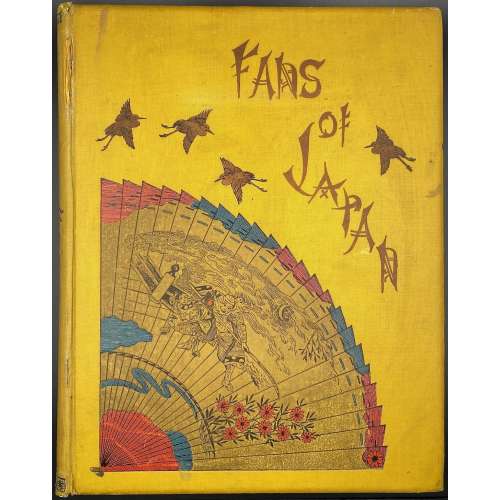 Description: Hardcover, 31.5 x 25 cm, yellow cloth adorned with stylized lettering and coloured design elements, blue endpapers, all margins red; Errata slip tipped in p.1. Lacks dust jacket. Inset: newspaper clipping titled "Facsimile of the fan distributed after the Tien-Tsin Massacre". Title-page: Fans of Japan | BY | CHARLOTTE M. SALWEY | née BIRCH | WITH INTRODUCTION BY | WILLIAM ANDERSON, F.R.C.S. | LATE OF H. M’S. LEGATION, JAPAN | AND | WITH TEN FULL-PAGE COLOURED PLATES, AND THIRTY-NINE | ILLUSTRATIONS IN BLACK AND WHITE | {publisher’s device} | LONDON | KEGAN PAUL, TRENCH, TRÜBNER & CO. LTD | PATERNOSTER HOUSE, CHARRING CROSS ROAD | 1894 || Pagination: [i-vi] vii-xix [xx] [1] 2-148 [4]; total 172 pages. Collation: 4to; π10 A-T4 (total 86 leaves) plus 10 colour plates with tissue guards and 39 b/w in-text illustrations. Plate I pasted in a kind of matt, though with red margins as all other pages. Printer: Ballantyne, Hanson and Co. Chromo-lithographer: McLagan and Cumming (Edinburgh) Publisher: Kegan Paul, Trench, Trübner & Co. Charles Kegan Paul (British, 1828 – 1902) – publisher. Author: Charlotte Maria Salwey [née Birch] (British, b. 1847 – after 1919). Introduction: William Anderson (British, 1842 – 1900) Dedicatee: Dr. Samuel Birch (British, 1813 – 1885)
Description: Hardcover, 31.5 x 25 cm, yellow cloth adorned with stylized lettering and coloured design elements, blue endpapers, all margins red; Errata slip tipped in p.1. Lacks dust jacket. Inset: newspaper clipping titled "Facsimile of the fan distributed after the Tien-Tsin Massacre". Title-page: Fans of Japan | BY | CHARLOTTE M. SALWEY | née BIRCH | WITH INTRODUCTION BY | WILLIAM ANDERSON, F.R.C.S. | LATE OF H. M’S. LEGATION, JAPAN | AND | WITH TEN FULL-PAGE COLOURED PLATES, AND THIRTY-NINE | ILLUSTRATIONS IN BLACK AND WHITE | {publisher’s device} | LONDON | KEGAN PAUL, TRENCH, TRÜBNER & CO. LTD | PATERNOSTER HOUSE, CHARRING CROSS ROAD | 1894 || Pagination: [i-vi] vii-xix [xx] [1] 2-148 [4]; total 172 pages. Collation: 4to; π10 A-T4 (total 86 leaves) plus 10 colour plates with tissue guards and 39 b/w in-text illustrations. Plate I pasted in a kind of matt, though with red margins as all other pages. Printer: Ballantyne, Hanson and Co. Chromo-lithographer: McLagan and Cumming (Edinburgh) Publisher: Kegan Paul, Trench, Trübner & Co. Charles Kegan Paul (British, 1828 – 1902) – publisher. Author: Charlotte Maria Salwey [née Birch] (British, b. 1847 – after 1919). Introduction: William Anderson (British, 1842 – 1900) Dedicatee: Dr. Samuel Birch (British, 1813 – 1885) -
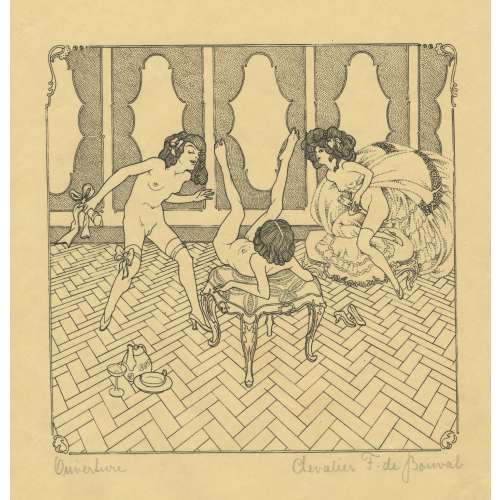 A set of sixteen planographic prints, signed and titled in pencil by owner “Chevalier F. de Bouval” (pseudonym of Franz von Bayros (Austrian, 1866 – 1924). Titles include: 1) Ouverture, 2) champagne brut, 3) maternité, 4) piano, 5) crudité délicieuse, 6. la belle vue, 7) au pensionnat, 8) le collier, 9) languelles pénètrelles, 10) introduction, 11) le sourrogat, 12) variation amoureuse, 13) la surprise, 14) le clef délicat, 15) le monstre gomme, 16) fruits de sud. Printed on wove paper, possibly engraved on wood after ink drawings by Franz von Bayros (Austrian, 1866 – 1924) under the pseudonym Chevalier F. de Bouval. Size: sheet 30 x 24 cm, image 18 x 17.5 cm. In another source, there are two more images from the same set: le passe-partout and la doublette, making 18 images altogether; the set is titled “Lesbia: XVIII sujets”, signed by Chevalier François René de Bouval.
A set of sixteen planographic prints, signed and titled in pencil by owner “Chevalier F. de Bouval” (pseudonym of Franz von Bayros (Austrian, 1866 – 1924). Titles include: 1) Ouverture, 2) champagne brut, 3) maternité, 4) piano, 5) crudité délicieuse, 6. la belle vue, 7) au pensionnat, 8) le collier, 9) languelles pénètrelles, 10) introduction, 11) le sourrogat, 12) variation amoureuse, 13) la surprise, 14) le clef délicat, 15) le monstre gomme, 16) fruits de sud. Printed on wove paper, possibly engraved on wood after ink drawings by Franz von Bayros (Austrian, 1866 – 1924) under the pseudonym Chevalier F. de Bouval. Size: sheet 30 x 24 cm, image 18 x 17.5 cm. In another source, there are two more images from the same set: le passe-partout and la doublette, making 18 images altogether; the set is titled “Lesbia: XVIII sujets”, signed by Chevalier François René de Bouval. -
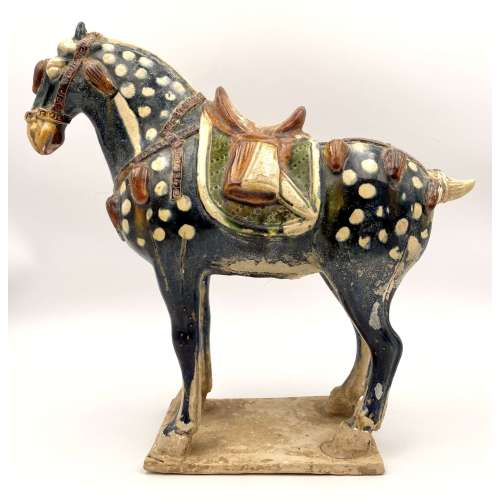 Moulded and sculpted earthenware horse with dark-blue, cream-dappled body, green and cream saddle pad, amber and cream saddle, and amber harness details. H: 28 cm.
Moulded and sculpted earthenware horse with dark-blue, cream-dappled body, green and cream saddle pad, amber and cream saddle, and amber harness details. H: 28 cm. -
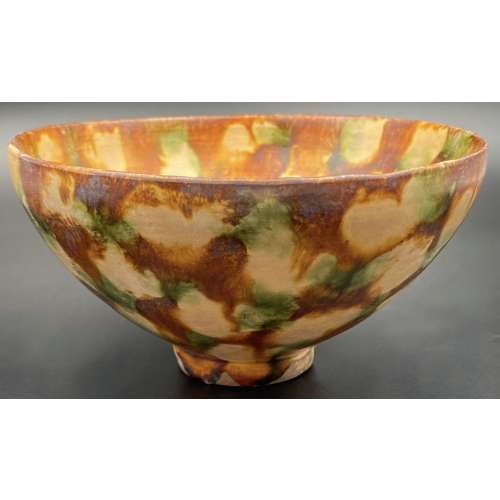 Footed bowl with deep, rounded sides decorated with cream and green splashes on amber background, inside and outside. Diameter: 13 cm; H: 7 cm.
Footed bowl with deep, rounded sides decorated with cream and green splashes on amber background, inside and outside. Diameter: 13 cm; H: 7 cm. -
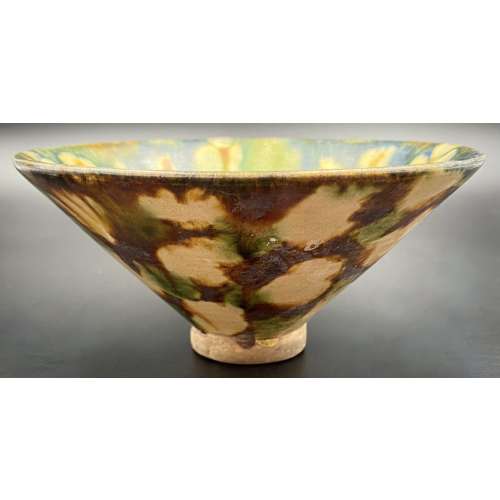 Footed conical bowl decorated with cream and brown splashes on green background inside, and cream and green splashes on the brown background outside. Diameter: 13.5 cm, H: 6.2 cm;
Footed conical bowl decorated with cream and brown splashes on green background inside, and cream and green splashes on the brown background outside. Diameter: 13.5 cm, H: 6.2 cm; -
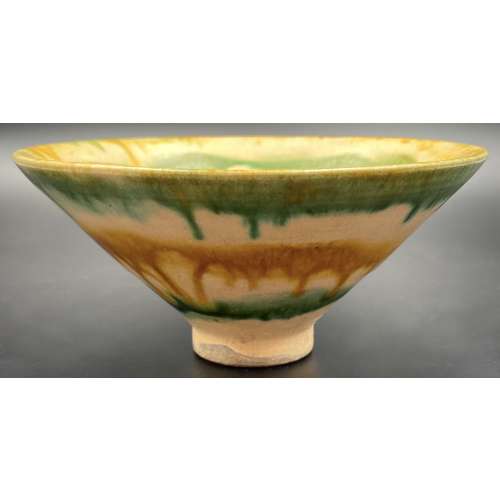 Footed conical bowl decorated with green and amber bleeding concentric circles on cream background inside and outside. Diameter: 13.5 cm, H: 6.2 cm;
Footed conical bowl decorated with green and amber bleeding concentric circles on cream background inside and outside. Diameter: 13.5 cm, H: 6.2 cm; -
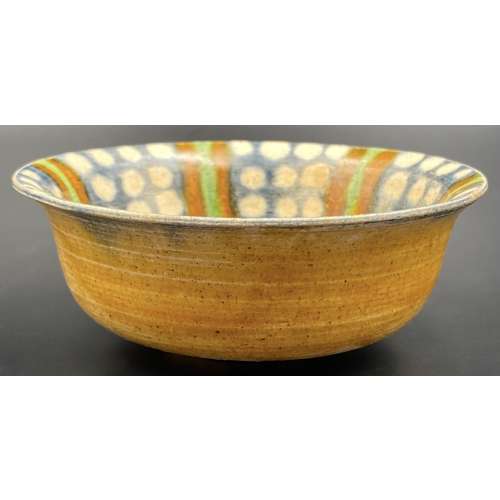 Small stoneware cup with rounded sides raising from a short foot to an inverted rim; glazed inside with a green and brown six-petal design on a blue background with creem dots. Amber glaze outside, blue bottom, foot unglazed. Dia: 10 cm; H: 4 cm.
Small stoneware cup with rounded sides raising from a short foot to an inverted rim; glazed inside with a green and brown six-petal design on a blue background with creem dots. Amber glaze outside, blue bottom, foot unglazed. Dia: 10 cm; H: 4 cm. -
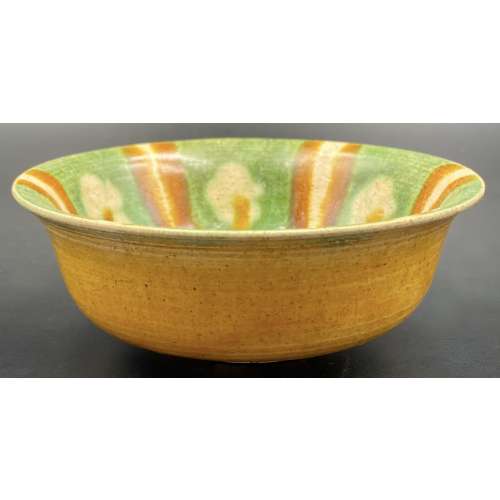 Small stoneware cup with rounded sides raising from a short foot to an inverted rim; glazed inside with a cream and brown six-petal design on a green background with cream and brown stylized flowers. Amber glaze outside, blue bottom, foot unglazed. Dia: 10 cm; H: 4 cm.
Small stoneware cup with rounded sides raising from a short foot to an inverted rim; glazed inside with a cream and brown six-petal design on a green background with cream and brown stylized flowers. Amber glaze outside, blue bottom, foot unglazed. Dia: 10 cm; H: 4 cm. -
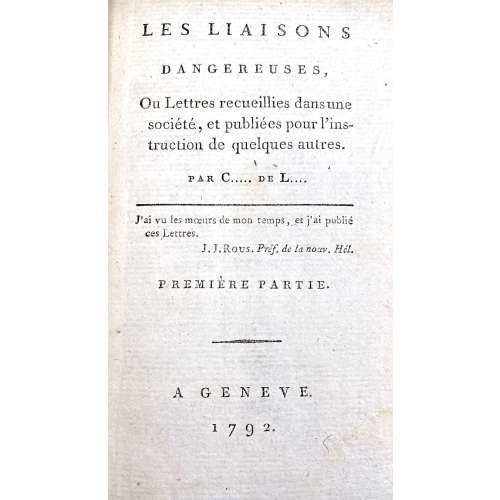 Four parts bound in two 18mo volumes (1-2 & 3-4), half polished brown calf, dot-ruled, flat spine with gilt bands and lettering, marbled boards, some plates with guard sheets, margins sparkled red. Title-page: LES LIAISONS | DANGEREUSES, | Ou Lettres recueillies dans une | société, et publiées pour l’ins- | truction de quelques autres. | par C….. de L… | — | J’ai vu les mœurs de mon temps, et j’ai publié | ces Lettres. | J. J. Rous. Préf. De la nouv. Hél. | PREMIÈRE PARTIE. | — | A GENEVE. | 1792. || Vol. 1: Pagination: ffep, blank, [2] – h.t., [i, ii] – t.p. part one, [iii] iv-xxij, [1] 2-245 [246] + 2 plates (p. 26 & p. 75); [1, 2] – h.t., [3, 4] – t.p. part two, [5] 6-233 [234], fep + 2 plates (p. 59 & p. 222). Collation: part 1: a12, A-M18 N5; part 2: A-M18 N9, plus four plates by various engravers after Le Barbier. Vol. 2: Pagination: ffep, blank, [1, 2] – h.t., [3, 4] – t.p. part three, [5] 6-225 [226] + 2 plates (p. 69 & p. 215); [1, 2] – h.t., [3, 4] – t.p. part four, [5] 6-250, fep + 2 plates (p. 25 & p. 201). Collation: part 3: A-M18 N5; part 4: A-N18 O5, plus four plates by various engravers after Le Barbier. Illustrations: After Le Barbier, engravers: Halbou (1), Simonet (1), N. Thomas (2), Dambrun (2), and Delignon (2). In the first illustration (vol. 1, part one, p. 26) Le Barbier signed “Le Barbier Jnv. 1794”, however, the edition was published (anonymously) in 1792. Cohen-De Ricci mentions an edition of 1794 (Paris: Maradan) and 1801 (Genéve) with the same plates. Lewine mentions a reprint of 1794 without naming the publisher. Catalogue raisonné: Cohen-De Ricci: 234-5, Ray: p. 79; Lewine: 109-10. Contributors: Choderlos de Laclos, Pierre Ambroise François (French, 1741 – 1803) – author. Le Barbier, Jean-Jacques-François (French, 1738 – 1826) – artist Engravers: Dambrun, Jean (French, 1741 – c. 1808) Delignon, Jean Louis (French, 1755 – 1804) Halbou, Louis Michel (1730 – 1809) Thomas, N. (French, c. 1750 – 1812) Simonet, Jean-Baptiste Blaise (French, 1742 – 1813)
Four parts bound in two 18mo volumes (1-2 & 3-4), half polished brown calf, dot-ruled, flat spine with gilt bands and lettering, marbled boards, some plates with guard sheets, margins sparkled red. Title-page: LES LIAISONS | DANGEREUSES, | Ou Lettres recueillies dans une | société, et publiées pour l’ins- | truction de quelques autres. | par C….. de L… | — | J’ai vu les mœurs de mon temps, et j’ai publié | ces Lettres. | J. J. Rous. Préf. De la nouv. Hél. | PREMIÈRE PARTIE. | — | A GENEVE. | 1792. || Vol. 1: Pagination: ffep, blank, [2] – h.t., [i, ii] – t.p. part one, [iii] iv-xxij, [1] 2-245 [246] + 2 plates (p. 26 & p. 75); [1, 2] – h.t., [3, 4] – t.p. part two, [5] 6-233 [234], fep + 2 plates (p. 59 & p. 222). Collation: part 1: a12, A-M18 N5; part 2: A-M18 N9, plus four plates by various engravers after Le Barbier. Vol. 2: Pagination: ffep, blank, [1, 2] – h.t., [3, 4] – t.p. part three, [5] 6-225 [226] + 2 plates (p. 69 & p. 215); [1, 2] – h.t., [3, 4] – t.p. part four, [5] 6-250, fep + 2 plates (p. 25 & p. 201). Collation: part 3: A-M18 N5; part 4: A-N18 O5, plus four plates by various engravers after Le Barbier. Illustrations: After Le Barbier, engravers: Halbou (1), Simonet (1), N. Thomas (2), Dambrun (2), and Delignon (2). In the first illustration (vol. 1, part one, p. 26) Le Barbier signed “Le Barbier Jnv. 1794”, however, the edition was published (anonymously) in 1792. Cohen-De Ricci mentions an edition of 1794 (Paris: Maradan) and 1801 (Genéve) with the same plates. Lewine mentions a reprint of 1794 without naming the publisher. Catalogue raisonné: Cohen-De Ricci: 234-5, Ray: p. 79; Lewine: 109-10. Contributors: Choderlos de Laclos, Pierre Ambroise François (French, 1741 – 1803) – author. Le Barbier, Jean-Jacques-François (French, 1738 – 1826) – artist Engravers: Dambrun, Jean (French, 1741 – c. 1808) Delignon, Jean Louis (French, 1755 – 1804) Halbou, Louis Michel (1730 – 1809) Thomas, N. (French, c. 1750 – 1812) Simonet, Jean-Baptiste Blaise (French, 1742 – 1813) -
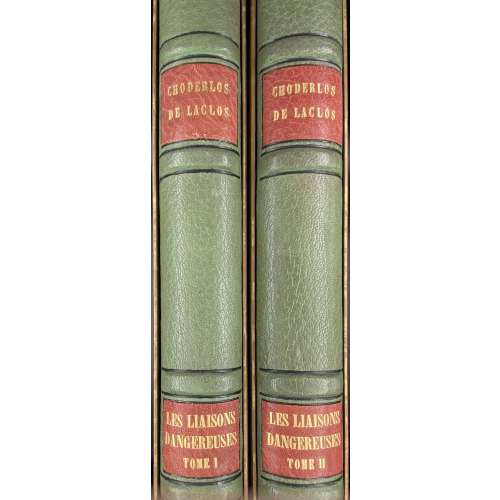 Description: Two volumes 34 x 26.5 cm each, each in a green/gilt marbled in a slipcase, bound in green morocco, spine with raised bands and two gilt-lettered brown labels, original wrappers bound in, marbled endpapers; printed on Montval watermarked wove paper, top margin gilt, outer and bottom margins untrimmed. Front wrapper (in oval red frame): CH. De LACLOS | LES | LIAISONS | DANGEREUSES | {fleuron} | TOME PREMIER (TOME SECOND) | — | CHEZ SYLVAIN SAUVAGE | 16 RUE CASSINI A PARIS | ANNO DOMINI | MCMXXX || Title-page (black and red): ~ CHODERLOS DE LACLOS ~ | LES | LIAISONS | DANGEREUSES | OU | LETTRES | RECUEILLIES DANS UNE SOCIETE ET | PUBLIEES POUR L’INSTRUCTION | DE QUELQUES AUTRES | {vignette} | TOME PREMIER (TOME SECOND) | AVEC DES FIGURES DE S. SAUVAGE | GRAVEES SUR CUIVRE AVEC LA COLLABORATION DE D.A.MAILLART | A PARIS EN L’AN GRACE | MCMXXX || Vol. 1: Collation: 2 blanks, 1 front wrapper, 1 blank/limitation, 1 h.t./frontis., 1 t.p., 3 advert., 1 d.t.p. première partie, 106 leaves, 1 blank, 1 back wrapper, 1 blank/spine, 1 blank; total within wrappers 114 leaves with woodcut fleurons and tailpieces, and 23 engraved and coloured plates, incl. frontispiece, full-page and in-text, some with tissue guards. Pagination: [14] [1] 2-211 [212] [2], ils. Vol. 2: 2 blanks, 1 front wrapper, 1 blank, 1 h.t./frontis., 1 t.p., 1 d.t.p., 109 leaves, 1 plate, 1 colophon, 1 back wrapper, 1 blank/spine, 1 blank; total within wrappers 115 leaves, with woodcut fleurons and tailpieces, and 25 engraved plates, engraved and coloured plates, incl. frontispiece, full-page and in-text, some with tissue guards. Pagination: [8] [1] 2-218 [4], ils. Limitation: Printed on September 29, 1930, 165 copies (1-165), the first four enriched with a suite of b/w plates and one original drawing; 10 copies for collaborators marked I-X. This is copy № 129. Contributors: Choderlos de Laclos, Pierre Ambroise François (French, 1741 – 1803) – author. Sylvain Sauvage [Félix Roy] (French, 1888 – 1948) – artist, publisher. Pierre Bouchet (text), Paul Haasen (plates) – printers.
Description: Two volumes 34 x 26.5 cm each, each in a green/gilt marbled in a slipcase, bound in green morocco, spine with raised bands and two gilt-lettered brown labels, original wrappers bound in, marbled endpapers; printed on Montval watermarked wove paper, top margin gilt, outer and bottom margins untrimmed. Front wrapper (in oval red frame): CH. De LACLOS | LES | LIAISONS | DANGEREUSES | {fleuron} | TOME PREMIER (TOME SECOND) | — | CHEZ SYLVAIN SAUVAGE | 16 RUE CASSINI A PARIS | ANNO DOMINI | MCMXXX || Title-page (black and red): ~ CHODERLOS DE LACLOS ~ | LES | LIAISONS | DANGEREUSES | OU | LETTRES | RECUEILLIES DANS UNE SOCIETE ET | PUBLIEES POUR L’INSTRUCTION | DE QUELQUES AUTRES | {vignette} | TOME PREMIER (TOME SECOND) | AVEC DES FIGURES DE S. SAUVAGE | GRAVEES SUR CUIVRE AVEC LA COLLABORATION DE D.A.MAILLART | A PARIS EN L’AN GRACE | MCMXXX || Vol. 1: Collation: 2 blanks, 1 front wrapper, 1 blank/limitation, 1 h.t./frontis., 1 t.p., 3 advert., 1 d.t.p. première partie, 106 leaves, 1 blank, 1 back wrapper, 1 blank/spine, 1 blank; total within wrappers 114 leaves with woodcut fleurons and tailpieces, and 23 engraved and coloured plates, incl. frontispiece, full-page and in-text, some with tissue guards. Pagination: [14] [1] 2-211 [212] [2], ils. Vol. 2: 2 blanks, 1 front wrapper, 1 blank, 1 h.t./frontis., 1 t.p., 1 d.t.p., 109 leaves, 1 plate, 1 colophon, 1 back wrapper, 1 blank/spine, 1 blank; total within wrappers 115 leaves, with woodcut fleurons and tailpieces, and 25 engraved plates, engraved and coloured plates, incl. frontispiece, full-page and in-text, some with tissue guards. Pagination: [8] [1] 2-218 [4], ils. Limitation: Printed on September 29, 1930, 165 copies (1-165), the first four enriched with a suite of b/w plates and one original drawing; 10 copies for collaborators marked I-X. This is copy № 129. Contributors: Choderlos de Laclos, Pierre Ambroise François (French, 1741 – 1803) – author. Sylvain Sauvage [Félix Roy] (French, 1888 – 1948) – artist, publisher. Pierre Bouchet (text), Paul Haasen (plates) – printers. -
 Woodblock print album of thirteen prints, ōban, nishiki-e. Artist: Chōkyōsai Eiri [鳥橋斎 栄里] (Japanese, fl. c. 1789 ~ 1801 ). Models of calligraphy (Fumi no kiyogaki), New Year 1801. This title is taken from Chris Uhlenbeck's Japanese Erotic Fantasies Sexual Imagery of the Edo Period. — Hotei Publishing, 2005, ISBN 90-74822-66-5):. A detailed description of the album can be found at The Complete Ukiyo-e Shunga №9 Eiri, 1996, ISBN 4-309-91019. Most of the edition is in Japanese, though Richard Lane writes a section in English: Eiri: Love-letters, Love Consummated: Fumi-no-kiyogaki. The article starts with the following statement: "Why all the fuss about Sharaku? Because he is so "mysterious"? No, not at all: because he is such a good artist. But Sharaku is not the only great yet enigmatic ukiyo-e artist and I propose to resurrect here one of his important contemporaries who has been all too long neglected: Chōkyōsai Eiri. As with many of the notable ukiyo-e masters, nothing is known of Eiri's biography. All we can say is what we learn from his extant prints and paintings: that he flourished during the second half of the Kansei Period [1789-1801]; and that he was a direct pupil of the great Eishi - who, being of eminent samurai stock, may well have attracted pupils of similar background." Another citation from Japanese Erotic Fantasies: "This album is one of the boldest sets of ōban-size shunga known, The first edition contains thirteen instead of the customary twelve designs". Here I present all thirteen prints, though the edition I bought in Kyoto in 2014 contained only twelve. The thirteenth print was purchased later in the United States (sheet №12).
Woodblock print album of thirteen prints, ōban, nishiki-e. Artist: Chōkyōsai Eiri [鳥橋斎 栄里] (Japanese, fl. c. 1789 ~ 1801 ). Models of calligraphy (Fumi no kiyogaki), New Year 1801. This title is taken from Chris Uhlenbeck's Japanese Erotic Fantasies Sexual Imagery of the Edo Period. — Hotei Publishing, 2005, ISBN 90-74822-66-5):. A detailed description of the album can be found at The Complete Ukiyo-e Shunga №9 Eiri, 1996, ISBN 4-309-91019. Most of the edition is in Japanese, though Richard Lane writes a section in English: Eiri: Love-letters, Love Consummated: Fumi-no-kiyogaki. The article starts with the following statement: "Why all the fuss about Sharaku? Because he is so "mysterious"? No, not at all: because he is such a good artist. But Sharaku is not the only great yet enigmatic ukiyo-e artist and I propose to resurrect here one of his important contemporaries who has been all too long neglected: Chōkyōsai Eiri. As with many of the notable ukiyo-e masters, nothing is known of Eiri's biography. All we can say is what we learn from his extant prints and paintings: that he flourished during the second half of the Kansei Period [1789-1801]; and that he was a direct pupil of the great Eishi - who, being of eminent samurai stock, may well have attracted pupils of similar background." Another citation from Japanese Erotic Fantasies: "This album is one of the boldest sets of ōban-size shunga known, The first edition contains thirteen instead of the customary twelve designs". Here I present all thirteen prints, though the edition I bought in Kyoto in 2014 contained only twelve. The thirteenth print was purchased later in the United States (sheet №12). №1: "...one of the most exotic scenes in all shunga. A Dutch kapitan is discovered coupling with a lovely Japanese courtesan, beside a large window opening upon a garden...".
№1: "...one of the most exotic scenes in all shunga. A Dutch kapitan is discovered coupling with a lovely Japanese courtesan, beside a large window opening upon a garden...".

 №2: "...a fair young harlot is seen masturbating with a grinding-pestle - a man watches intently from under bedding." [I have two specimens of this design; the one from album is more soiled but less faded].
№2: "...a fair young harlot is seen masturbating with a grinding-pestle - a man watches intently from under bedding." [I have two specimens of this design; the one from album is more soiled but less faded].
 №3: "...the artist has effectively contrasted the lovers by depicting the man's face as seen through the geisha's gauze skirt. [...] we are impressed more by strikingly elegant composition, the dramatic coloring, rather than feeling any great urge to participate in the energetic proceedings..."
№3: "...the artist has effectively contrasted the lovers by depicting the man's face as seen through the geisha's gauze skirt. [...] we are impressed more by strikingly elegant composition, the dramatic coloring, rather than feeling any great urge to participate in the energetic proceedings..."
 №4: "This scene is a most straightforward one, featuring the standard Missionary Position [capitalization by R. Lane].; but withal, the contrast of the young and naked, secret lover and the richly-clothed courtesan amid luxurious bedding..."
№4: "This scene is a most straightforward one, featuring the standard Missionary Position [capitalization by R. Lane].; but withal, the contrast of the young and naked, secret lover and the richly-clothed courtesan amid luxurious bedding..."
 №5: "In a striking lesbian scene (which has no equivalent in Utamaro, and is, incidentally, often omitted in later editions of this album), the girl at left prepares to receive the harikata (dildo) worn by the older girl at right (who holds a seashell containing lubricant)."
№5: "In a striking lesbian scene (which has no equivalent in Utamaro, and is, incidentally, often omitted in later editions of this album), the girl at left prepares to receive the harikata (dildo) worn by the older girl at right (who holds a seashell containing lubricant)."
 №6: "In the first appearance of a matronly heroine in this series, we find a widow - with shaven eyebrows and clipped hair - sporting with a handsome yound shop-clerk, mounting him with all her might."
№6: "In the first appearance of a matronly heroine in this series, we find a widow - with shaven eyebrows and clipped hair - sporting with a handsome yound shop-clerk, mounting him with all her might."

 №7: "... lady of samurai court: here, shown taking advantage of an official outing to temple and theatre, to rendezvous with a secret lover on a teahouse balcony." R. Lane considers this design the least successful in the series, especially in comparison with the same theme by Utamaro: "Utamaro female is almost ferocious in her lust for sexual gratification", which does not sound true to me. See Utamaro's sheet №5 from the album Utamakura (歌まくら, Poem of the Pillow) [courtesy The British Museum without permission]:
№7: "... lady of samurai court: here, shown taking advantage of an official outing to temple and theatre, to rendezvous with a secret lover on a teahouse balcony." R. Lane considers this design the least successful in the series, especially in comparison with the same theme by Utamaro: "Utamaro female is almost ferocious in her lust for sexual gratification", which does not sound true to me. See Utamaro's sheet №5 from the album Utamakura (歌まくら, Poem of the Pillow) [courtesy The British Museum without permission]:
 Then, as Richard Lane states, "we are flung suddenly to the bottom rung of Edo society":
Then, as Richard Lane states, "we are flung suddenly to the bottom rung of Edo society":
 №8: "Here we find a fair yotaka ('night-hawk', e.i. streetwalker) accommodating a lusty client in a lumberyard by the bank of the Sumida River".
№8: "Here we find a fair yotaka ('night-hawk', e.i. streetwalker) accommodating a lusty client in a lumberyard by the bank of the Sumida River".
 №9: '... a slightly plump harlot of the lower class receives a night visit from her lover, whose naked form she tries to cover with a cloak."
№9: '... a slightly plump harlot of the lower class receives a night visit from her lover, whose naked form she tries to cover with a cloak."
 №10: "...likely maidservant and lackey - are depicted in bath-room, their passions are all too obviously fired by steaming water."
№10: "...likely maidservant and lackey - are depicted in bath-room, their passions are all too obviously fired by steaming water."
 №11: "...this scene of courtesan and secret lover ranks high not only in Eiri's œuvre but also in the annals of the ukiyo-e genre itself. Both design and colouring are impeccable and, for this period, there is nothing even in the work of great Utamaro that really surpasses it." Again, a doubtful statement, however, this is Utamaro's design for the reader to judge:
№11: "...this scene of courtesan and secret lover ranks high not only in Eiri's œuvre but also in the annals of the ukiyo-e genre itself. Both design and colouring are impeccable and, for this period, there is nothing even in the work of great Utamaro that really surpasses it." Again, a doubtful statement, however, this is Utamaro's design for the reader to judge:
 The last design in my album is this:
The last design in my album is this:
 #13: In most reference books it goes under number 13, and we will assign this number to the sheet. "The final scene of the album features naked participants, probably samurai man and wife. The print is rather subdued in tone and colour, if not in the degree of the passion displayed..."
An additional sheet, acquired separately from a reputable dealer in New York, is usually listed as №12:
#13: In most reference books it goes under number 13, and we will assign this number to the sheet. "The final scene of the album features naked participants, probably samurai man and wife. The print is rather subdued in tone and colour, if not in the degree of the passion displayed..."
An additional sheet, acquired separately from a reputable dealer in New York, is usually listed as №12:
 №12: "One might think that Eiri has reached his peak with the preceding plate 11 - and indeed he has, in both esthetic and erotic terms. But the album is not yet finished, and the next scene lends a needed variety to the series, a slightly comic tableau featuring a middle-aged lackey attempting to forcibly seduce a servant girl of the same domicile". Utamaro's design, that inspired Eiri is here:
№12: "One might think that Eiri has reached his peak with the preceding plate 11 - and indeed he has, in both esthetic and erotic terms. But the album is not yet finished, and the next scene lends a needed variety to the series, a slightly comic tableau featuring a middle-aged lackey attempting to forcibly seduce a servant girl of the same domicile". Utamaro's design, that inspired Eiri is here:
 All descriptions are taken from Richard Lane's article at The Complete Ukiyo-e Shunga №9 Eiri, 1996. He concluded: "...Eiri's erotic series represents a major contribution to shunga art towards the close of ukiyo-e "Golden Age". In part inspired by Utamaro's classic album, this series withal constitutes a unified and original achievement, providing a cumulative effect of gracefully elegant yet glowing eroticism, which remains in the mind's eye long after the pictures themselves are far away."
I only would like to mention here that in several reference sources this album goes under name of Eisho; unfortunately, this mistake is reproduced at www.ukiyo-e.org, which miraculously shows exactly my print, but under the wrong name of the artist. The same mistake can be found at Shunga. The art of love in Japan. Tom and Mary Anne Evans. Paddington Press Ltd., 1975. ISBN 0-8467-0066-2; plates 6.74-6.77: Chōkyōsai Eishō, c. 1800. Even the British Museum edition of 2010 gives the same erroneous attribution: Chōkyōsai Eishō (1793-1801); they provide the following translation of title: "Clean Draft of a Letter" [see: Shunga. Erotic art in Japan. Rosina Buckland. The British Museum Press, 2010; pp. 110-112]. To the honour of the British Museum, I must admit that they have corrected themselves in Shunga. Sex and pleasure in Japanese art. Edited by Timothy Clark, et al. Hotei Publishing, 2013. Now, they say Chōkyōsai Eiri (worked c. 1790s-1801); they also provide a new title: "Neat Version of the Love Letter, or Pure Drawings of Female Beauty". I have already mentioned Richard Lane's version of title: "Love-letters, Love Consummated", and Chris Uhlenbeck's "Models of calligraphy". In poorly designed and printed Shunga. Erotic figures in Japanese art. Presented by Gabriele Mandel. Translated by Alison L'Eplattenier. Crescent Books, New York, 1983, the artist is named Shokyosai Eisho (beginning of the 19th century); title provided: "Models of Calligraphy". Correct attribution to Chōkyōsai Eiri also can be found at Poem of the pillow and other stories by Utamaro, Hokusai, Kuniyoshi and other artists of the floating world. Gian Carlo Calza in collaboration with Stefania Piotti. Phaidon Press, 2010; though the title is translated as "Clean Copy of Female Beauty".
All descriptions are taken from Richard Lane's article at The Complete Ukiyo-e Shunga №9 Eiri, 1996. He concluded: "...Eiri's erotic series represents a major contribution to shunga art towards the close of ukiyo-e "Golden Age". In part inspired by Utamaro's classic album, this series withal constitutes a unified and original achievement, providing a cumulative effect of gracefully elegant yet glowing eroticism, which remains in the mind's eye long after the pictures themselves are far away."
I only would like to mention here that in several reference sources this album goes under name of Eisho; unfortunately, this mistake is reproduced at www.ukiyo-e.org, which miraculously shows exactly my print, but under the wrong name of the artist. The same mistake can be found at Shunga. The art of love in Japan. Tom and Mary Anne Evans. Paddington Press Ltd., 1975. ISBN 0-8467-0066-2; plates 6.74-6.77: Chōkyōsai Eishō, c. 1800. Even the British Museum edition of 2010 gives the same erroneous attribution: Chōkyōsai Eishō (1793-1801); they provide the following translation of title: "Clean Draft of a Letter" [see: Shunga. Erotic art in Japan. Rosina Buckland. The British Museum Press, 2010; pp. 110-112]. To the honour of the British Museum, I must admit that they have corrected themselves in Shunga. Sex and pleasure in Japanese art. Edited by Timothy Clark, et al. Hotei Publishing, 2013. Now, they say Chōkyōsai Eiri (worked c. 1790s-1801); they also provide a new title: "Neat Version of the Love Letter, or Pure Drawings of Female Beauty". I have already mentioned Richard Lane's version of title: "Love-letters, Love Consummated", and Chris Uhlenbeck's "Models of calligraphy". In poorly designed and printed Shunga. Erotic figures in Japanese art. Presented by Gabriele Mandel. Translated by Alison L'Eplattenier. Crescent Books, New York, 1983, the artist is named Shokyosai Eisho (beginning of the 19th century); title provided: "Models of Calligraphy". Correct attribution to Chōkyōsai Eiri also can be found at Poem of the pillow and other stories by Utamaro, Hokusai, Kuniyoshi and other artists of the floating world. Gian Carlo Calza in collaboration with Stefania Piotti. Phaidon Press, 2010; though the title is translated as "Clean Copy of Female Beauty".
-

An iron tsuba of slightly vertically elongated circular form carved and pierced with a mass of ivy (tsuta) leaves and tendrils, details damascened with gold in nunome-zōgan technique. Hitsu-ana with raised rim.
Unsigned.
Chōshū school.Height: 72.0 mm; width: 69.0 mm; thickness: 4.7 mm; Weight: 92 g.
According to John W. Dower, "ivy bears fairly close resemblance to both maple leaf and grape leaf". However, I consider this tsuba decorated with ivy leaves for several reasons, such as the lack of racemations in the presence of tendrils. -
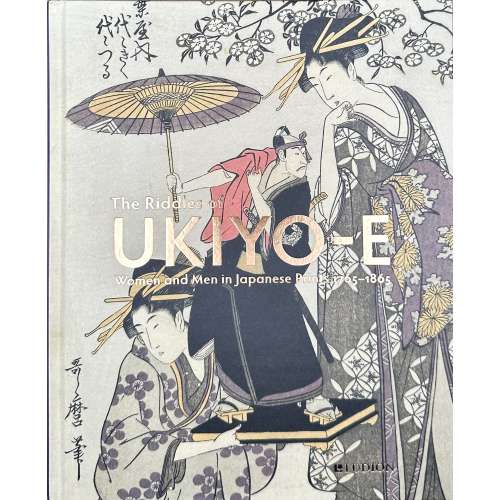 NEWHardcover volume 295 x 240 mm, pictorial front cover and purple spine with gilt embossed lettering, back cover with orange lettering, craft endpapers, pp.: [1-6] 7-255 [1], profusely illustrated. Exhibition catalogue with 123 reproductions of Japanese woodblock prints. Title-page: The Riddles of | UKIYO-E | Women and Men in Japanese Prints 1765–1865 | Chris Uhlenbeck / Jim Dwinger / Josephine Smit | {publisher’s device LUDION} || Table of contents: Preface; Introduction; Beauties; Shunga; Legends; Kabuki; INDEX; LIST OF WORKS; BIBLIOGRAPHY; AUTHORS.
NEWHardcover volume 295 x 240 mm, pictorial front cover and purple spine with gilt embossed lettering, back cover with orange lettering, craft endpapers, pp.: [1-6] 7-255 [1], profusely illustrated. Exhibition catalogue with 123 reproductions of Japanese woodblock prints. Title-page: The Riddles of | UKIYO-E | Women and Men in Japanese Prints 1765–1865 | Chris Uhlenbeck / Jim Dwinger / Josephine Smit | {publisher’s device LUDION} || Table of contents: Preface; Introduction; Beauties; Shunga; Legends; Kabuki; INDEX; LIST OF WORKS; BIBLIOGRAPHY; AUTHORS.


